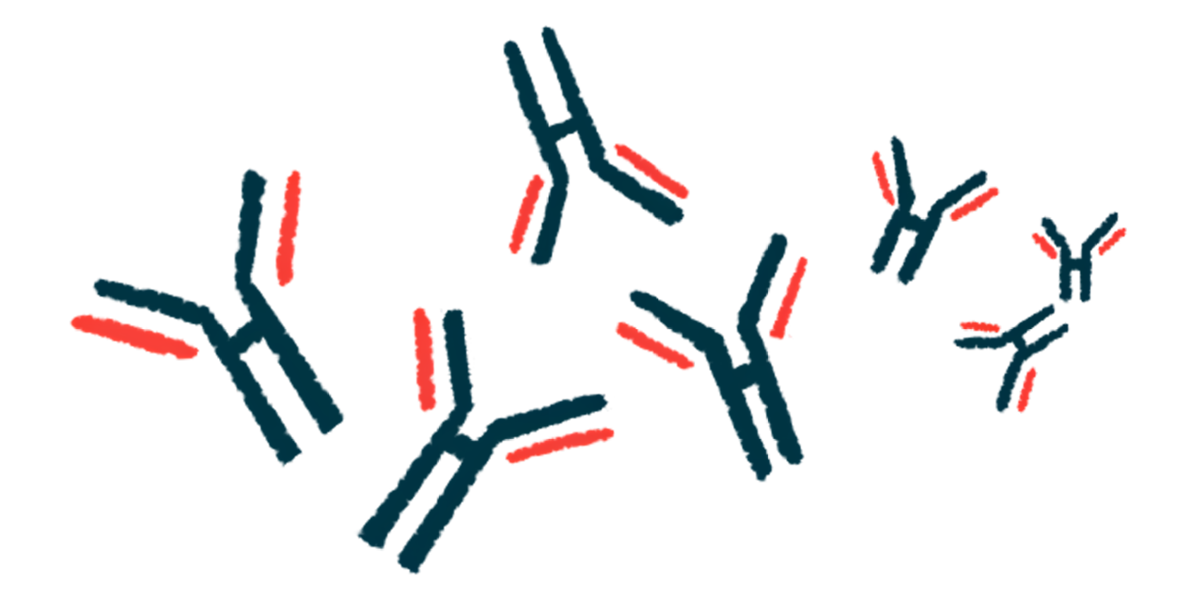gMG patients can carry treatment resistant autoantibodies, study finds
These self-reactive antibodies drive disease but are untouched by therapies

People with generalized myasthenia gravis (gMG) can carry certain types of self-reactive antibodies — proteins that mistakenly target the body’s own cells and tissues — that drive the disease but are treatment resistant, according to a new study by Yale School of Medicine researchers.
These self-reactive antibodies, or autoantibodies, remain untouched by some therapeutics, the researchers found.
Further, the binding strength of these self-reactive antibodies and the associated underlying disease-causing mechanisms were seen to fluctuate over time, with changes related to MG severity in some patients, the data showed.
“We suggest incorporating comprehensive [self-reactive] antibody profiling into future MG clinical trials to further investigate potential associations with treatment outcomes,” the researchers wrote.
The study, “AChR Autoantibody Pathogenic Properties Are Heterogeneously Distributed and Undergo Temporal Changes Among Patients With Myasthenia Gravis,” was published in the journal Neuroimmunology & Neuroinflammation.
Most cases of MG are caused by autoantibodies that target acetylcholine receptor proteins (AChRs) on muscle cells. AChRs are protein receptors that bind and respond to acetylcholine, a chemical messenger released by nerve cells to stimulate muscle contraction.
Seeking to understand why certain autoantibodies are treatment resistant
Autoantibodies cause disease through several mechanisms, such as by blocking AChR-acetylcholine binding, or forcing the receptors to move from the cell membrane to the inside of the cell (receptor internalization) and be degraded. They can also activate the complement system, a group of proteins that normally help the immune system defend the body against microbes — which further contributes to damage the point of contact between nerve and muscle cells.
Two classes of therapies approved to treat MG are complement inhibitors, which are designed to suppress complement activation, and FcRn blockers, which lower the levels of antibodies circulating in the blood, particularly those belonging to the immunoglobulin G (IgG) class.
Both approaches improve outcomes for many MG patients. Still, some individuals don’t respond to treatment because complement inhibitors may not address AChR internalization or blockage, and FcRn inhibitors may not affect other types of antibodies (isotypes), including IgM and IgA, or other IgG subclasses.
“Understanding how different pathogenic [disease-causing] mechanisms, isotypes, and IgG subclasses are represented in the AChR autoantibody repertoire could lead to more precise application of therapeutics,” the researchers wrote.
To learn more, the team analyzed blood samples collected from 50 gMG patients who were positive for anti-AChR antibodies every six months for two years.
The samples were collected as part of the Phase 2 BeatMG study (NCT02110706), which assessed the safety and potential benefits of antibody-based therapy rituximab in people with MG. Marketed as Rituxan and other brand names, rituximab is an infusion therapy that works to reduce the levels of antibody-producing B-cells, and is sometimes used off-label to treat MG.
Autoantibody profiling recommended for future MG clinical trials
Blood tests taken before treatment revealed that most patients (74%) had anti-AChR IgG autoantibodies alone, while some had IgG and IgA (6%), IgG and IgM (8%), or all three isotypes (4%).
Regarding IgG subclasses, IgG1 was found in about two-thirds of the patients, followed by IgG3 in one-fifth, and IgG2 in one-sixth, or less than 20%. Nearly half (45.6%) had IgG1 autoantibodies alone, with a few patients having IgG2 alone, IgG3 alone, or different antibody combinations.
“These findings highlight diverse distributions of AChR autoantibody isotypes and IgG subclasses among patients with MG,” the team wrote.
Complement activation was the primary MG-causing mechanism in nearly all patients (as many as 84.8%), but it rarely occurred alone (10.8%). Instead, some individuals also exhibited AChR internalization (45.6%), AChR blocking (10.8%), or both (17.4%). Blocking alone was rarely seen (2.1%), and receptor internalization alone was never observed.
“The successful use of complement inhibitors in treating gMG further highlights the prevalent contribution of complement activity to MG [disease development],” the researchers wrote.
A stronger IgG binding capacity was tied to increased complement activation and AChR internalization, but not with AChR blocking. Moreover, none of the different autoantibody mechanisms correlated with standard measures of disease severity.
Future clinical trials in MG should incorporate comprehensive autoantibody profiling to investigate links with treatment outcomes.
The researchers then tested samples from a subset of BeatMG participants who received a placebo over the two-year study. The tests revealed significant fluctuations in the binding capacities of IgG, IgA, IgM, and IgG antibody subclasses over time. Complement activation, AChR internalization, and blocking also varied over time and among patients, with some changes related to disease severity.
When the team examined samples from rituximab-treated patients, they found that treatment decreased IgG binding capacity at one year. Likewise, it decreased AChR internalization and blocking at six months and one year. The results were similar among patients who didn’t receive any other immunosuppressants, except rituximab, data showed.
“This investigation highlights the complexity and diversity of the AChR autoantibody repertoire, suggesting its potential impact on patient responses to treatments,” the team wrote. “Future clinical trials in MG should incorporate comprehensive autoantibody profiling to investigate links with treatment outcomes.”








